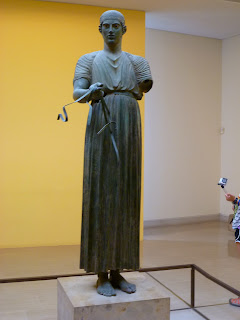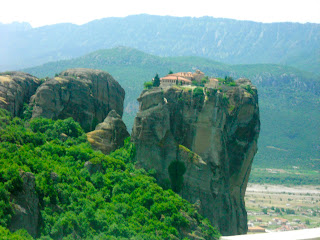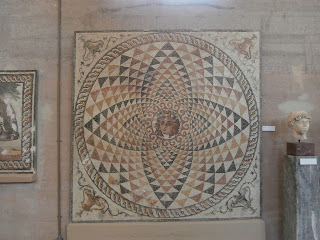After we were done touring the Olympic area, we got back on
the bus and headed for ancient Corinth. First we went to the small
archaeological museum that housed some of the sculptures, pottery, jewelry,
etc. that had been found during the excavation process. Then we headed outside
to walk through the ancient city of Corinth.
First we stopped at the Temple of Apollo, which still has 7
Doric columns standing today. It is quite large, and it was easy to see how
when it was fully together, it would have been massive. The Temple of Apollo,
along with the Temple of Aphrodite on Acrocorinth, no doubt played a major role
in why God had Paul stay for so long. According to Acts 18, Paul stayed to preach in Corinth for 18 months.
We continued to tour the ruins of the city, seeing the
Temple of Octavia, and then we came upon the bema of Corinth. In Acts 18, after Paul has been teaching
for a while, we see that the Jews of Corinth decided to drag Paul in front of
Gallio, the proconsul, because his message contradicted theirs. The place of
judgment that they took him to was the bema, which is the raised platform in
the city, and still stands today. After Paul was brought there by the Jews, the
Roman ruler of the area released him because the charges had nothing to do with
the Roman law, and were only a religious matter.


Therefore, Paul was allowed to keep working and preaching in
the city of Corinth, likely in the agora. This was the marketplace, where the
shops and day-to-day happenings occurred. Paul was a tentmaker, and with Aquila
and Priscilla, the Jews who befriended him according to Acts 18, he likely made his living by working in the agora. Some
remnants of shops still exist, so we can see what it would have been like
working out there everyday, and let me tell you, it would have been extremely
hot!
Then we finished walking around the ruins, seeing two other
important parts of the ancient city of Corinth. First, there is the Lechaion
Road, which was the main road between Corinth and the northern port, where
travelers came and went. Then there was the Peirene Fountain, which also is
connected to another part up on Acrocorinth. This fountain, according to myths,
inspired many writers and poets, and even Pegasus had drank from the fountain
before being captured.
After our walk, we grabbed lunch and then got back on the
bus to drive up to as far as the bus could reach near Acrocorinth.
Unfortunately, the parking lot was still a way from the top, so we had quite a
climb ahead of us. The views were amazing driving up, so we knew we needed to
do the hike to get even better ones.

The acropolis of ancient Corinth is on top of a monolithic
rock that was fortified multiple times by different empires. It looks basically
like a large castle, because you can see the old walls surrounding much of the
top. It took about a half hour to reach a clearing, but there was still massive
hikes to reach the top on both sides. At the very edge of the right side, there
was the Temple of Aphrodite. Although there really isn’t any remnants left, this
temple is often believed to be the place of the 1,000 priestesses, or temple
prostitutes, that ancient Corinth was known for. No doubt one of the many
reasons Paul talked about real love to the Corinthians, especially in his first
letter.





After climbing back down, we drove out to the Isthmus of
Corinth and the Corinth Canal, which connects the Peloponnese Peninsula to
mainland Greece. The Isthmus of Corinth is a narrow land bridge, four miles
wide, and many different rulers tried unsuccessfully to create a canal for
hundreds of years. Finally in the late 1800’s the canal was finished so that
ships could pass through.
Visiting Ancient Corinth was really memorable because it gave us a feel for another place that Paul had been. And with the background knowledge of the city, it helps us understand why Paul needed to be there for so long, preaching the message of Jesus Christ.
~Katherine and Kelsey














































